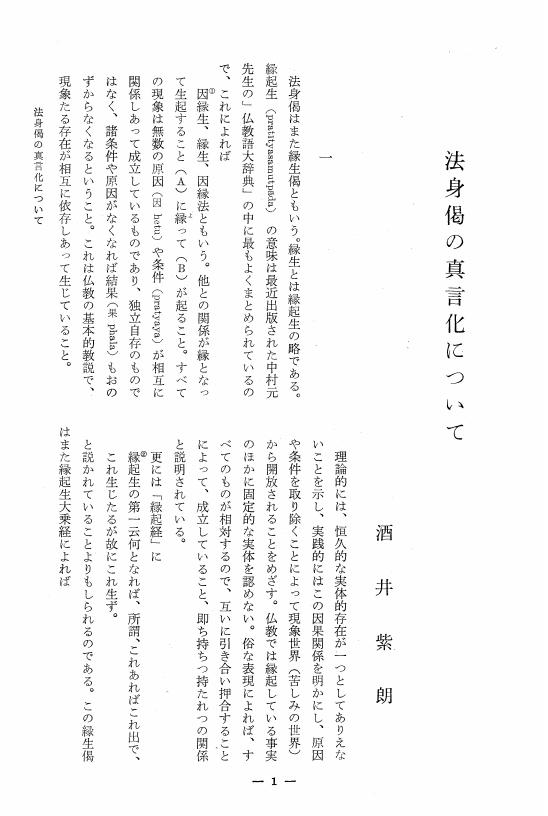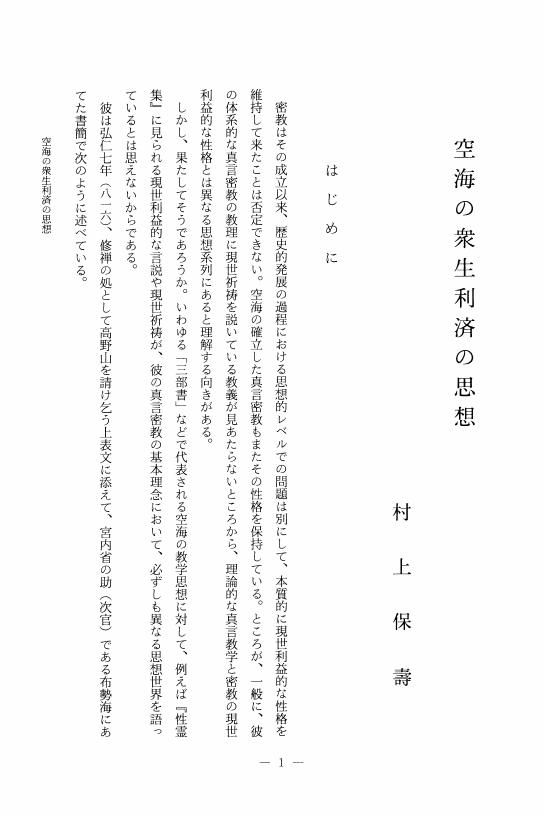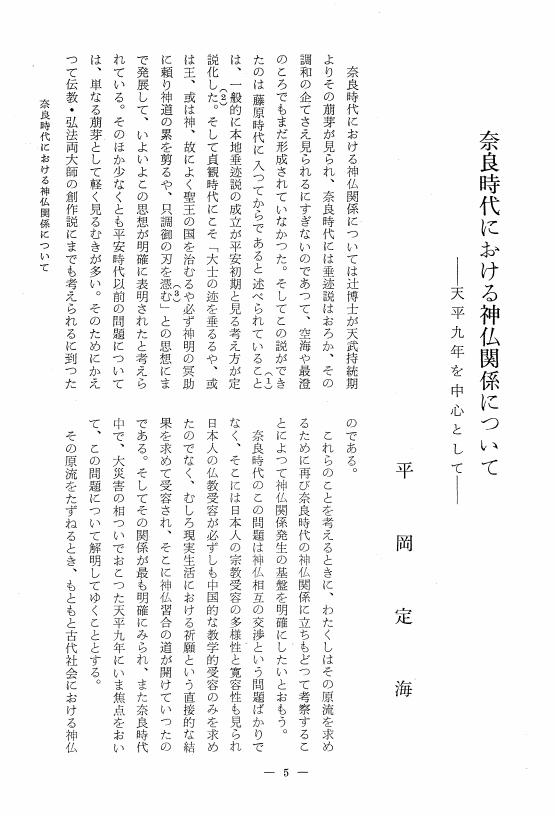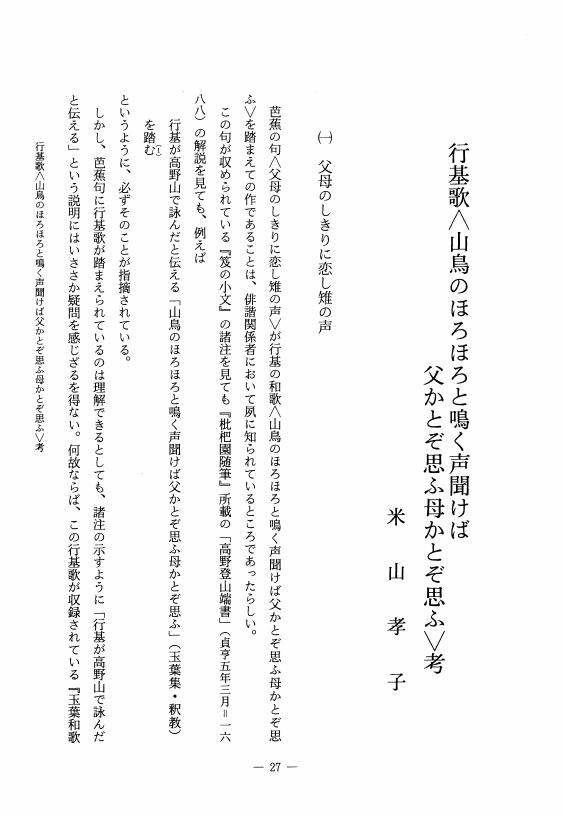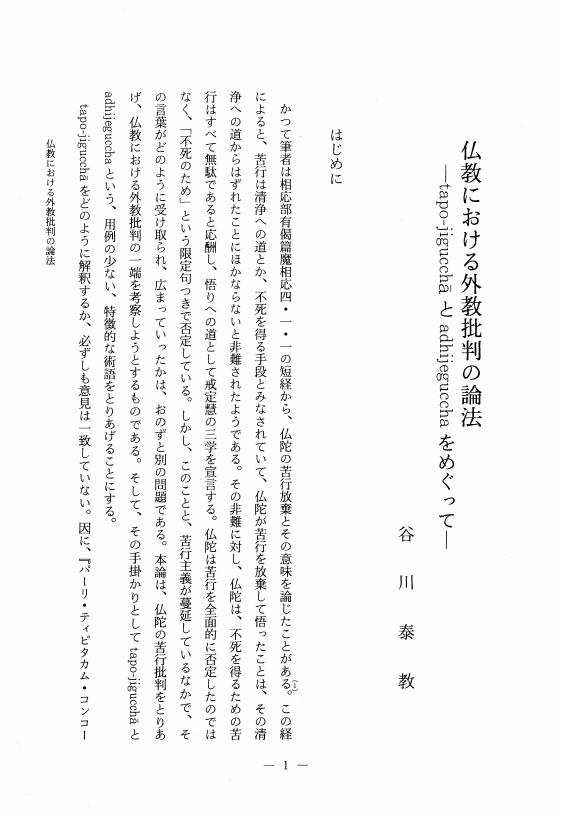1 0 0 0 OA ヘーツ・タットブァ・ウパデーシャ 後期仏教論理学の一小品
- 著者
- 宮坂 宥勝
- 出版者
- 密教研究会
- 雑誌
- 密教文化 (ISSN:02869837)
- 巻号頁・発行日
- vol.1955, no.29-30, pp.L83-L67, 1955-05-20 (Released:2010-03-12)
1 0 0 0 OA 根源的人間 エックハルトに於ける「真人」(ein wâr mensche) について
- 著者
- 上田 閑照
- 出版者
- 密教研究会
- 雑誌
- 密教文化 (ISSN:02869837)
- 巻号頁・発行日
- vol.1973, no.101, pp.31-45, 1973-01-15 (Released:2010-03-12)
1 0 0 0 OA 般若三蔵について (上) その思想と時代背景
- 著者
- 頼富 本宏
- 出版者
- 密教研究会
- 雑誌
- 密教文化 (ISSN:02869837)
- 巻号頁・発行日
- vol.1974, no.108, pp.33-55, 1974-11-25 (Released:2010-03-12)
1 0 0 0 OA 倫理道徳と宗教、あるいは文化と非文化 和辻倫理学批判
- 著者
- 竹内 亨
- 出版者
- 密教研究会
- 雑誌
- 密教文化 (ISSN:02869837)
- 巻号頁・発行日
- vol.1984, no.145, pp.51-67, 1984-01-21 (Released:2010-03-12)
1 0 0 0 OA 法身偈の真言化について
- 著者
- 酒井 紫朗
- 出版者
- 密教研究会
- 雑誌
- 密教文化 (ISSN:02869837)
- 巻号頁・発行日
- vol.1975, no.111, pp.1-10, 1975-08-01 (Released:2010-03-12)
1 0 0 0 OA 金剛乗とタントラ分類
- 著者
- 静 春樹
- 出版者
- 密教研究会
- 雑誌
- 密教文化 (ISSN:02869837)
- 巻号頁・発行日
- vol.2006, no.217, pp.L7-L32,141, 2006-12-21 (Released:2010-03-12)
- 参考文献数
- 19
The commentators on the Sarvatathagatatattvasamgraha-sutra (TS) divided Mahayana into Vajrayana and Paramitayana. They furthermore defined the overall history of Indian esoteric Buddhism as the history of Tantrism, and positioned as lower stages (Kriya, Carya) the entirety of early esoteric Buddhism, beginning with the arising of a new theory of praxis different from the practices of the paramitas before the formation of the TS. Afterwards, tantras with different doctrinal teachings and practice structures were grouped together in a way that was simultaneously a system of classification.This paper focuses on the four-fold and five-fold classification systems which were established after the Yogini-tantras appeared. An issue between two models will be shown to be the question of the relative ascendancy of the so-called Mother Tantra over Father Tantra. Next, the classificatory standard lying at the root of the differences between the two classification systems will be studied. Finally, regardless of differences in the criterion between two systems, the overall agreement of the acaryas on the five-fold tantra-grouping framework (Kriya, Carya, Yoga, Mahdyoga and Yogini) based on the historical development will be concluded.
1 0 0 0 OA 恵果阿闍梨との出逢い
- 著者
- 岡村 圭真
- 出版者
- 密教研究会
- 雑誌
- 密教文化 (ISSN:02869837)
- 巻号頁・発行日
- vol.1966, no.77-78, pp.138-154, 1966-11-15 (Released:2010-03-12)
1 0 0 0 OA 空海の衆生利済の思想
- 著者
- 村上 保壽
- 出版者
- 密教研究会
- 雑誌
- 密教文化 (ISSN:02869837)
- 巻号頁・発行日
- vol.1994, no.185, pp.1-16, 1994-03-15 (Released:2010-03-12)
- 被引用文献数
- 1
1 0 0 0 OA 宗教と医療 小林参三郎と済世病院での実践
- 著者
- 室田 保夫
- 出版者
- 密教研究会
- 雑誌
- 密教文化 (ISSN:02869837)
- 巻号頁・発行日
- vol.1995, no.190, pp.L128-L113, 1995-02-25 (Released:2010-03-12)
1 0 0 0 OA 大雲 (請雨) 経第六十四・六十五品の一考察
- 著者
- 大山 仁快
- 出版者
- 密教研究会
- 雑誌
- 密教文化 (ISSN:02869837)
- 巻号頁・発行日
- vol.1961, no.55, pp.47-71, 1961-06-01 (Released:2010-03-12)
1 0 0 0 OA 学の論理 ヘーゲル『論理の学』研究序説
- 著者
- 山脇 雅夫
- 出版者
- 密教研究会
- 雑誌
- 密教文化 (ISSN:02869837)
- 巻号頁・発行日
- vol.1995, no.191, pp.L127-L109, 1995-06-25 (Released:2010-03-12)
1 0 0 0 OA 奈良時代における神仏関係について 天平九年を中心として
- 著者
- 平岡 定海
- 出版者
- 密教研究会
- 雑誌
- 密教文化 (ISSN:02869837)
- 巻号頁・発行日
- vol.1965, no.71-72, pp.5-20, 1965-04-01 (Released:2010-03-12)
1 0 0 0 OA 行基歌〈山鳥のほろほろと鳴く声聞けば父かとぞ思ふ母かとぞ思ふ〉考
- 著者
- 米山 孝子
- 出版者
- 密教研究会
- 雑誌
- 密教文化 (ISSN:02869837)
- 巻号頁・発行日
- vol.1995, no.189, pp.27-49, 1995-01-25 (Released:2010-03-12)
1 0 0 0 ホームレスと人権保障:釜ケ崎における公的扶助の役割
- 著者
- 上畑 恵宣
- 出版者
- 密教研究会
- 雑誌
- 密教文化 (ISSN:02869837)
- 巻号頁・発行日
- vol.1994, no.188, pp.L111-L94, 1994
1 0 0 0 OA 観賢僧正の教学 (続)
- 著者
- 大山 公淳
- 出版者
- 密教研究会
- 雑誌
- 密教文化 (ISSN:02869837)
- 巻号頁・発行日
- vol.1968, no.85, pp.1-15, 1968-10-30 (Released:2010-03-12)
1 0 0 0 OA 高野の聖たち 高野山一心院谷の場合
- 著者
- 山陰 加春夫
- 出版者
- 密教研究会
- 雑誌
- 密教文化 (ISSN:02869837)
- 巻号頁・発行日
- vol.2007, no.218, pp.57-82,151, 2007-03-21 (Released:2010-03-12)
In the mid-seventeenth century, nearly all of the temple compounds on Koyasan were managed by Kongobu-ji temple. However, Koyasan of the thirteenth century was divided into three power bases: the Kongobu-ji faction, the Daidenbo-in faction, and the Kangosanmai-in faction. In the periphery of these three factions and not directly connected to any were the hijiri, who formed their own groups on Koyasan. In the thirteenth century the area known at present as Isshin'in-dani was occupied by a temple connected to Ninna-ji called Isshin-in, where hijiri known as shonin lived.
- 著者
- 谷川 泰教
- 出版者
- 密教研究会
- 雑誌
- 密教文化 (ISSN:02869837)
- 巻号頁・発行日
- vol.1997, no.198, pp.1-34, 1997-03-31 (Released:2010-03-12)
1 0 0 0 OA 不空三蔵の訳経活動をめぐる一考察 乾元元年の訳経許可文書を中心として
- 著者
- 岩本 弘
- 出版者
- 密教研究会
- 雑誌
- 密教文化 (ISSN:02869837)
- 巻号頁・発行日
- vol.1998, no.199-200, pp.69-92, 1998-03-31 (Released:2010-03-12)
1 0 0 0 OA 信玄公護身旗の梵字真言に就いて
- 著者
- 白石 真道
- 出版者
- 密教研究会
- 雑誌
- 密教文化 (ISSN:02869837)
- 巻号頁・発行日
- vol.1956, no.33, pp.L46-L38_1, 1956-04-20 (Released:2010-03-12)
1 0 0 0 OA 原始佛教における転輪聖王
- 著者
- 中野 義照
- 出版者
- 密教研究会
- 雑誌
- 密教文化 (ISSN:02869837)
- 巻号頁・発行日
- vol.1956, no.32, pp.4-19, 1956-02-20 (Released:2010-03-12)




